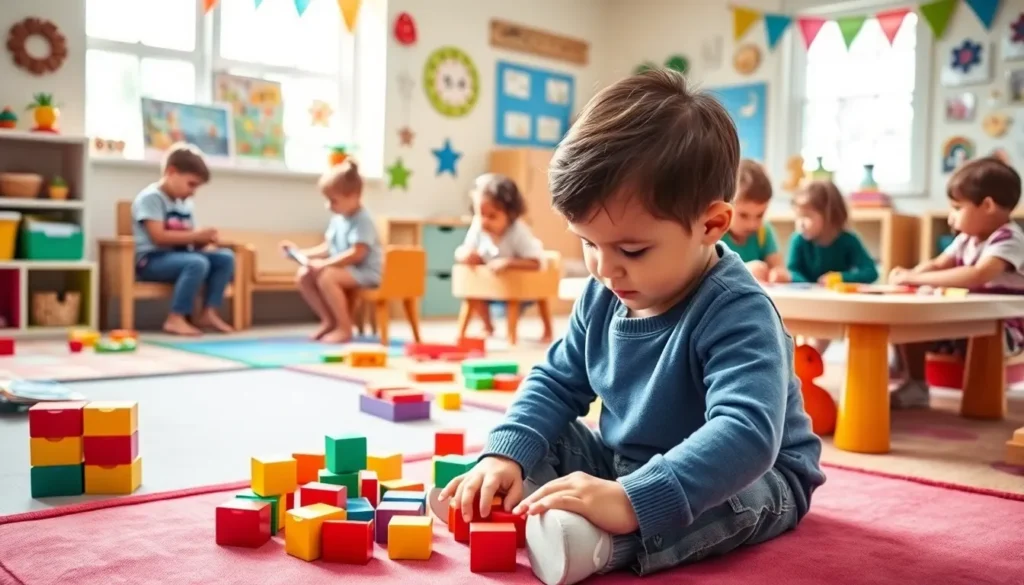The first day of school can feel like stepping onto a rollercoaster without knowing if it’s a thrilling ride or a dizzying disaster. From new teachers to unfamiliar hallways, it’s a whirlwind of excitement and anxiety. But fear not! With the right tips, this day can transform from terrifying to terrific.
Table of Contents
ToggleImportance of the First Day of School
The first day of school sets the tone for the entire academic year. Establishing routines on this day helps students feel grounded. Students often experience a mix of excitement and anxiety, making this day crucial for emotional well-being. Positive interactions can foster friendships and create a sense of belonging that lasts throughout the year.
A warm welcome from teachers influences students’ attitudes. Engaging with peers during icebreakers transforms initial nerves into connections, promoting a supportive atmosphere. Parents play a pivotal role by encouraging their children and discussing plans for the day. A calm departure contributes to a smoother transition.
First impressions matter, as they influence how students perceive their learning environment. Classroom organization, welcoming decorations, and clear expectations create an inviting space. Feedback from the first day often shapes teachers’ approaches for the semester, adapting to varied student needs.
Setting goals also begins on this significant day. Encouraging students to identify academic and personal objectives strengthens their motivation. Emphasizing positivity from the onset enhances their approach to challenges ahead.
Ultimately, the first day of school serves as a foundation for growth. Building confidence and instilling a sense of achievement can lead to a more successful educational experience. Maintaining open communication between teachers, students, and parents creates an enduring support system that benefits everyone involved.
Preparing for the Big Day

Preparation ensures a smoother transition into the new school year. Being organized and ready helps reduce anxiety and fosters confidence.
Organizing School Supplies
Gather necessary school supplies before the first day starts. Notebooks, pens, pencils, and folders top the list of essentials. Creating a checklist simplifies the process, ensuring nothing crucial gets overlooked. Designating a specific spot for supplies helps keep everything in order. Using colorful labels on folders can make them easily identifiable. This visual organization reduces morning chaos and allows easy access to materials. Also, checking school supply lists enables students to arrive fully equipped. Staying ahead of the game prepares students for a successful start.
Planning the Outfit
Choosing an outfit ahead of time sets a positive tone for the first day. Select clothing that feels comfortable and stylish to boost confidence. Students should consider the weather and school dress codes when making their choices. Trying on potential outfits in advance avoids last-minute surprises. Accessories can add a personal touch, making the outfit unique. Planning shoes that are both fashionable and comfortable helps prevent distractions throughout the day. Finalizing the outfit the night before simplifies morning routines. Feeling good in what they wear can positively impact students’ interactions and overall experience.
Building Confidence
Building confidence on the first day of school enhances the overall experience. Students can approach new situations with assurance, setting a positive tone for the year ahead.
Practicing Introductions
Practicing introductions before the first day creates comfort in meeting new classmates. Students can start by discussing their interests and hobbies, making connections easier. Engaging in role-playing scenarios with friends or family helps ease anxiety. Focusing on a firm handshake and maintaining eye contact portrays confidence. Speaking slowly and clearly makes conversations more pleasant. By rehearing these interactions, students feel prepared to break the ice and forge new friendships.
Familiarizing with the School Layout
Familiarizing with the school layout reduces uncertainty and boosts confidence. Touring the school before classes begin offers valuable insights into classroom locations and facilities. Finding essential spots, like the cafeteria, library, and restrooms, eases feelings of being lost. Utilizing maps or school apps can simplify navigation on the first day. Exploring the surroundings helps students recognize helpful resources and connect with peers. Knowledge of the school layout fosters independence, allowing them to move through the day with ease.
Managing First Day Jitters
First day jitters can feel overwhelming. Embracing effective strategies can help students navigate their emotions and foster confidence.
Techniques for Relaxation
Deep breathing exercises significantly reduce anxiety. Inhale deeply through the nose, hold for a few seconds, then exhale slowly through the mouth. Visualizing a peaceful scene also calms nerves; encouraging students to picture a comforting place helps lower stress levels. Gentle stretches can release tension from the body. Engaging in positive self-talk reinforces confidence; reminding oneself of past successes creates a calming effect. Parents should support students by practicing these techniques together, fostering a sense of security as the day approaches.
Positive Mindset Strategies
Setting realistic expectations ensures a positive outlook. Accepting that nerves are normal helps students feel more prepared. Imagining successful interactions with peers encourages a constructive mindset. Focusing on personal goals for the day reinforces motivation; writing down one academic and one social goal can guide them through experiences. Surrounding oneself with supportive friends enhances positivity. Reminders of past achievements spark confidence and remind students of their ability to adapt. Employing these mindset strategies creates a foundation for a successful first day at school.
Engaging with Teachers and Peers
Building connections with classmates and teachers enriches the school experience, promoting an encouraging learning environment.
Approaching New Classmates
Starting conversations with new classmates helps ease first-day nerves. Smile and make eye contact to show openness. Asking simple questions about their interests or sharing personal hobbies can break the ice. Inviting peers to participate in activities or projects generates collaboration and friendship. Joining group discussions or clubs also provides great opportunities to meet others with similar interests. Remaining approachable encourages classmates to engage as well, ultimately leading to lasting connections.
Tips for Talking to Teachers
Talking to teachers on the first day sets a positive tone for future interactions. Introduce yourself and express enthusiasm for the upcoming year. Asking questions about class expectations or materials demonstrates eagerness to learn. Requesting clarification on assignments fosters a supportive relationship and shows that a student values the teacher’s guidance. Remembering to thank teachers after conversations leaves a lasting, positive impression. Being proactive in communication helps create a foundation for success, enhancing both engagement and academic growth.
The first day of school can be a transformative experience. With the right preparation and mindset students can turn anxiety into excitement and build lasting connections. By fostering positive interactions and establishing routines students set the stage for a successful academic year.
Parents also play a crucial role in this journey by providing encouragement and support. Ultimately the first day is just the beginning of a year filled with growth and achievement. Embracing the experience with confidence and an open mind can lead to a fulfilling school year ahead.




